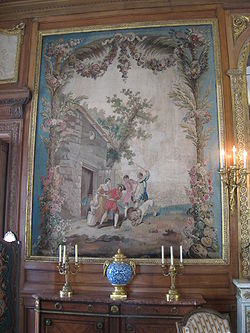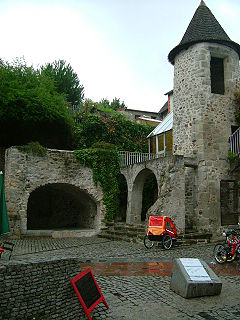
Aubusson, Creuse
Encyclopedia
Aubusson is a commune
in the Creuse
department in the Limousin
region
in central France
.
and the Beauze. The route national N141 goes through the town.
The town was known as Albuciensis in 936 and under the name Albuconis in 1070.
The name possibly originates from a name of a man, Albucius Other scholars claim the name is from a Celt
ic word meaning craggy. In the Middle Ages the town was ruled by viscount
s. The vicecomital family also produced a troubadour
named Joan d'Aubusson
.

and carpets, which have been famous throughout the world since the 14th century. Its origins were born with the arrival of weavers from Flanders
, who took refuge in Aubusson around 1580. There is a famous collection of Aubusson tapestries at Vallon-Pont-d'Arc
. The style of the tapestries produced has changed through the centuries, from scenes of green landscapes through to hunting scenes. In the 17th Century, the Aubusson and Felletin workshops were given "Royal Appointment" status. A downturn in fortunes came after the French revolution and the arrival of wallpaper. However, tapestry made something of a comeback during the 1930s, with artists such as Cocteau, Dufy, Dali, Braque, Calder and Picasso being invited to Aubusson to express themselves through the medium of wool. Aubusson tapestry still thrives today, preserving a range of traditional skills. In 1983, l’Atelier Raymond Picaud chose Burhan Doğançay
's Ribbon Series as a tapestry subjects. Coventry cathedral
's famous Christ in Glory tapestry, designed by artist Graham Sutherland
, was woven in nearby Felletin
. Installed in 1962, this was the world's largest vertical tapestry up until the 1990s.


Around 1263/1266 the vice-county was sold to the count of La Marche.
Communes of France
The commune is the lowest level of administrative division in the French Republic. French communes are roughly equivalent to incorporated municipalities or villages in the United States or Gemeinden in Germany...
in the Creuse
Creuse
Creuse is a department in central France named after the Creuse River.-History:Creuse is one of the original 83 departments created during the French Revolution on 4 March 1790. It was created from the former province of La Marche....
department in the Limousin
Limousin (région)
Limousin is one of the 27 regions of France. It is composed of three départements: Corrèze, Creuse and the Haute-Vienne.Situated largely in the Massif Central, as of January 1st 2008, the Limousin comprised 740,743 inhabitants on nearly 17 000 km2, making it the second least populated region of...
region
Régions of France
France is divided into 27 administrative regions , 22 of which are in Metropolitan France, and five of which are overseas. Corsica is a territorial collectivity , but is considered a region in mainstream usage, and is even shown as such on the INSEE website...
in central France
France
The French Republic , The French Republic , The French Republic , (commonly known as France , is a unitary semi-presidential republic in Western Europe with several overseas territories and islands located on other continents and in the Indian, Pacific, and Atlantic oceans. Metropolitan France...
.
Geography
Aubusson is situated in the southern part of the département, at the confluence of the Creuse RiverCreuse River
The Creuse is a 264 km long river in western France, a tributary of the river Vienne. Its source is in the Plateau de Millevaches, a north-western extension of the Massif Central...
and the Beauze. The route national N141 goes through the town.
History
Aubusson has existed at least since the Gallo-Roman period. The Camp des Châtres, within the town’s boundaries, for a long time considered a Roman fort, actually dates back a little further, to the Iron Age.The town was known as Albuciensis in 936 and under the name Albuconis in 1070.
The name possibly originates from a name of a man, Albucius Other scholars claim the name is from a Celt
Celt
The Celts were a diverse group of tribal societies in Iron Age and Roman-era Europe who spoke Celtic languages.The earliest archaeological culture commonly accepted as Celtic, or rather Proto-Celtic, was the central European Hallstatt culture , named for the rich grave finds in Hallstatt, Austria....
ic word meaning craggy. In the Middle Ages the town was ruled by viscount
Viscount
A viscount or viscountess is a member of the European nobility whose comital title ranks usually, as in the British peerage, above a baron, below an earl or a count .-Etymology:...
s. The vicecomital family also produced a troubadour
Troubadour
A troubadour was a composer and performer of Old Occitan lyric poetry during the High Middle Ages . Since the word "troubadour" is etymologically masculine, a female troubadour is usually called a trobairitz....
named Joan d'Aubusson
Joan d'Aubusson
Joan d'Aubusson or d'Albusson , known as Johan or Johanet to Occitan contemporaries , was an Auvergnat troubadour and a Ghibelline. Only three of his works survive: two tensos and a cobla.Joan was often present at the court of the viscount Peter of Aubusson and his wife Margaret...
.

Tapestry
Aubusson is well-known for its tapestryTapestry
Tapestry is a form of textile art, traditionally woven on a vertical loom, however it can also be woven on a floor loom as well. It is composed of two sets of interlaced threads, those running parallel to the length and those parallel to the width ; the warp threads are set up under tension on a...
and carpets, which have been famous throughout the world since the 14th century. Its origins were born with the arrival of weavers from Flanders
Flanders
Flanders is the community of the Flemings but also one of the institutions in Belgium, and a geographical region located in parts of present-day Belgium, France and the Netherlands. "Flanders" can also refer to the northern part of Belgium that contains Brussels, Bruges, Ghent and Antwerp...
, who took refuge in Aubusson around 1580. There is a famous collection of Aubusson tapestries at Vallon-Pont-d'Arc
Vallon-Pont-d'Arc
Vallon-Pont-d'Arc is a commune in the Ardèche department in southern France.Vallon-Pont-d'Arc is a capital of prehistoric and cultural tourism. This small village, peaceful in wintertime, sees its population expand ten-fold in summer...
. The style of the tapestries produced has changed through the centuries, from scenes of green landscapes through to hunting scenes. In the 17th Century, the Aubusson and Felletin workshops were given "Royal Appointment" status. A downturn in fortunes came after the French revolution and the arrival of wallpaper. However, tapestry made something of a comeback during the 1930s, with artists such as Cocteau, Dufy, Dali, Braque, Calder and Picasso being invited to Aubusson to express themselves through the medium of wool. Aubusson tapestry still thrives today, preserving a range of traditional skills. In 1983, l’Atelier Raymond Picaud chose Burhan Doğançay
Burhan Dogançay
-Biography:Burhan Dogançay obtained his artistic training from his father Adil Doğançay, and Arif Kaptan, both well-known Turkish painters. In his youth, Dogançay played on the Turkish Gençlerbirliği soccer team. In 1950, he received a law degree from the University of Ankara, Turkey...
's Ribbon Series as a tapestry subjects. Coventry cathedral
Coventry Cathedral
Coventry Cathedral, also known as St Michael's Cathedral, is the seat of the Bishop of Coventry and the Diocese of Coventry, in Coventry, West Midlands, England. The current bishop is the Right Revd Christopher Cocksworth....
's famous Christ in Glory tapestry, designed by artist Graham Sutherland
Graham Sutherland
Graham Vivien Sutherland OM was an English artist.-Early life:He was born in Streatham, attending Homefield Preparatory School, Sutton. He was then educated at Epsom College, Surrey before going up to Goldsmiths, University of London...
, was woven in nearby Felletin
Felletin
Felletin is a commune in the Creuse department in the Limousin region in central France.-Geography:An area of lakes and streams, forestry and farming comprising a small town and several villages and hamlets situated by the banks of the Creuse River just south of Aubusson at the junction of the...
. Installed in 1962, this was the world's largest vertical tapestry up until the 1990s.
Population
Musée Départemental de la Tapisserie
Created in 1981, the museum exhibits nearly 600 years of tapestry creation and production. This rich collection is composed of 17th, 18th and 19th Century tapestries and carpets. As well as works from its own collection, there are also regular exhibitions of tapestries from around the world, showcasing works right up to the present day.Maison du Tapissier
This is a permanent exhibition that is staged in an ancient Creusois house in Aubusson. The interior tells the history and traditions of tapestry as well as showing furniture of the period.

Historical buildings
- The Clock Tower
- The old town (ancient buildings)
- Sainte-Croix church
- Ruins of the chateau (also called le Chapitre)
Rulers
In the medieval period, Aubusson was a vice-county. Its rulers were:- Ranulf I ?-934
- Robert I 934-942
- Renaud I 942-958 (son of Ranulf I)
- Ranulf II Cabridel 958-1031
- Ranulf III 1031-1060
- Renaud III 1060-1069
- William I 1069-1106
- Renaud IV 1106-?
- Renaud V The Leper ?-1185
- Guy I 1185- ?
- Renaud VI ?-1249
- Ranulf V 1249-c. 1265
- William II (heir) 1263, lord of La Borne, La Feuillade, Monteil-au-Vicomte, Poux, Pintarion and Damoiseau (1317), started a noble line that continued with his son Renaud VIII (1317–1353) and his successors.
Around 1263/1266 the vice-county was sold to the count of La Marche.
Personalities
- Jules SandeauJules SandeauLeonard Sylvain Julien Sandeau was a French novelist.He was born at Aubusson , and was sent to Paris to study law, but spent much of his time in unruly behaviour with other students. He met George Sand, then Madame Dudevant, at Le Coudray in the house of a friend, and when she came to Paris in...
(1811–1883), member of the Académie françaiseAcadémie françaiseL'Académie française , also called the French Academy, is the pre-eminent French learned body on matters pertaining to the French language. The Académie was officially established in 1635 by Cardinal Richelieu, the chief minister to King Louis XIII. Suppressed in 1793 during the French Revolution,... - Alfred Assollant (1827–1886), Children’s author – “The Adventures of Capitain Corcoran”. He was a notable opponent of Napoleon III.
- Camille Benassy (1887–1958), mayor of Aubusson but also a national politician.

